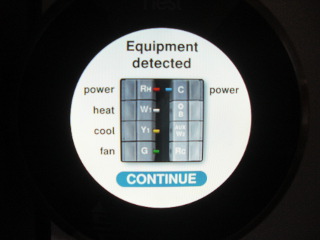
My furnace's control board. The "C" terminal has no connection to the thermostat in this picture. (The white wire on the C terminal goes to the A/C.) I connected the unused blue wire (bottom center) to the C terminal.
I recently bought and installed a Nest Learning Thermostat to replace my old non-networked thermostat. I show the installation, demonstrate control from mobile devices, and provide a general review in the above video.
It's been about a month since I installed the device, and I found one important issue yesterday. My Nest dropped off the network for 7 hours, and upon investigation I discovered that the battery was low and it turned off the Wi-Fi radio to save power. Many other people have reported problems with the battery, which is scary because your thermostat is one device that you absolutely want to work 24/7 -- you don't want your pipes freezing when you leave town and the Nest decides to run out of juice!
It turns out that my thermostat wiring, like in many homes, does not provide a "C" wire (common 24VAC) for completing a circuit that provides constant power to the unit. This sort of wiring worked great for old-fashioned mercury thermostats -- it provides a red 24VAC power wire, and "call" wires for turning on the fan, heat, and air conditioning. When the thermostat needs to turn on one of those appliances, it simply closes the circuit between the red wire and the relevant call wire. Smart thermostats rely on batteries to power their smartness when no circuit is closed. When an appliance is running (i.e. one of those three circuits is closed), it can perform "power stealing" to sap power from the closed circuit for its operation and recharging the battery. For simple programmable thermostats, power stealing is probably sufficient. However, for a power-hungry device like the Nest that needs to operate a Wi-Fi radio, this mode of operation can be problematic for several reasons:
- If you live in a nice place like Colorado where you can open the windows and go days without using the heater or air conditioner, the control circuits are never closed and the Nest's battery doesn't have an opportunity to recharge.
- Power stealing is an imperfect backwards compatibility hack, and can't necessarily provide enough current to recharge the battery even when the appliances are operating. This is because the current may be limited by resistance in your furnace's control board.
- When the HVAC appliances are not running and the battery needs to be charged, the Nest performs an even worse hack than power stealing: it pulses the heater call circuit on and off very quickly to steal some power, and hopes that the pulses are short enough to keep the furnace from activating. I haven't noticed any problem with this, but at least one person has found that this wrecks havoc on their heater.
- The Nest uses a "Power Saving Mode" of Wi-Fi to reduce the power consumption of the radio and prolong the battery life. (And hopefully require less overall power than it can steal from the call circuits.) Nest indicates that some non-conformant wireless access points may not fully support this mode, thus causing the Nest to consume more power. (Perhaps more quickly than it can be replenished.)
I was lucky that my thermostat wiring contained an extra, unused (blue) wire, and my furnace's control board provided a 24VAC common terminal for a "C" wire. After hooking up the blue wire at the furnace and the Nest's base, I now seem to have successfully provided a 24VAC "C" wire to the Nest, and hopefully my battery issues are behind me.
I do think that Nest is perhaps overly optimistic about their power stealing and circuit pulsing being able to provide adequate power to the device. There's certainly no warning about this potential issue when you provide your wiring information to their online compatibility tool.
References
- Undocumented Nest incompatibility with single-stage wiring - Marco Arment of Instapaper fame reports on his experience with this issue.
- Options for adding "C" wire to thermostat - Stack Exchange
- Thermostat signals and wiring - a great resource for understanding thermostat wiring.
- When Nest needs a common "C" wire - The Nest support page for this topic (which somewhat downplays the severity of the issue).
posted at 2012-08-30 11:41:54 US/Mountain
by David Simmons
tags: thermostat nest home automation electronics
permalink
comments


